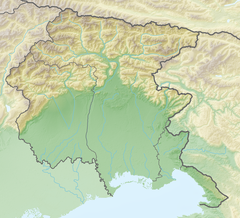1976 Friuli earthquake
 | |
| UTC time | 1976-05-06 20:00:12 |
|---|---|
| ISC event | 713583 |
| USGS-ANSS | ComCat |
| Local date | May 6, 1976 |
| Local time | 20:00:13[1] |
| Magnitude | 6.5 Mw[1] |
| Depth | 10 km (6.2 mi)[1] |
| Epicenter | 46°22′N 13°19′E / 46.37°N 13.32°ECoordinates: 46°22′N 13°19′E / 46.37°N 13.32°E[1] |
| Type | Dip-slip[2] |
| Areas affected | Italy Yugoslavia |
| Max. intensity | X (Extreme) [3] |
| Foreshocks | 4.5 mb May 6 at 19:59[4] |
| Casualties | 990 dead[2] 1,700–3,000 injured[2] |
The 1976 Friuli earthquake, also known in Italy as Terremoto del Friuli (Friulian earthquake), took place on May 6, 1976, with a moment magnitude of 6.5 and a maximum Mercalli intensity of X (Extreme). The shock occurred in the Friuli region in northeast Italy near the town of Gemona del Friuli. 990 people were killed,[5] up to about 3,000 were injured, and more than 157,000 were left homeless.
Earthquake[]
The quake struck at 21:00:13 (20:00:13 UTC). Seventy-seven villages in the Friuli region were affected. Gemona del Friuli was greatly damaged and despite extensive emergency measures and international aid by the end of 1976 15,000 people were still living in camping trailers, 1000 in tents and 25000 in evacuation centres. The damage was estimated at $4.25 million.[6] Much of the town has since been reconstructed. The tremor was felt in Venice as well as neighboring Austria, Switzerland and Slovenia (at the time SFR Yugoslavia) and Germany. In Slovenia, the upper Soča valley and the Brda area was particularly affected, with the village of Breginj nearly completely demolished. The earthquake damaged several buildings in Nova Gorica and was felt also in the Slovenian capital, Ljubljana.

The Italian Government nominated Chamber of Deputies member Giuseppe Zamberletti as coordinator of aid efforts on behalf of the regional administration. The national funds were assigned to the reconstruction of the damaged buildings by Zamberletti and the regional council of Friuli Venezia Giulia. From September to December 1976 all the earthquake victims were accommodated into prefabricated buildings, in order to better cope with the winter. Many local inhabitants lived in the Government supplied trailers for many years while homes were rebuilt. After Zamberletti's mandate the regional government of Friuli Venezia Giulia was able to completely rebuild many towns, thanks to an accurate resource management, however some towns took over a decade to fully recover. Nowadays, many years after the tragedy, the State's intervention, the earthquake management and reconstruction in Friuli Venezia Giulia are seen as a great example of efficiency and reliability.[7]
Aftershocks[]
There were many aftershocks with the two sets of strong shocks on 11 September (16:31, 5.5 Msand 16:35, 5.4 Ms ) and again on 15 September (3:15, 6.0 Ms and 9:21, 5.9 Ms ) 1976.[4]
Aftermath[]
This event also spurred the foundation of the Protezione Civile (the Italian Civil Defense body that deals with nationwide prevention and management of emergencies and catastrophic events).
See also[]
References[]
- ^ a b c d ISC (2015), ISC-GEM Global Instrumental Earthquake Catalogue (1900–2009), Version 2.0, International Seismological Centre
- ^ a b c USGS (September 4, 2009), PAGER-CAT Earthquake Catalog, Version 2008_06.1, United States Geological Survey, archived from the original on 2020-03-13
- ^ National Geophysical Data Center / World Data Service (NGDC/WDS) (1972), Significant Earthquake Database (Data Set), National Geophysical Data Center, NOAA, doi:10.7289/V5TD9V7K
- ^ a b Cipar, John (1980), "Teleseismic observations of the 1976 Friuli, Italy earthquake sequence", Bulletin of the Seismological Society of America, Seismological Society of America, 70 (4): 966
- ^ Lessi, Davide (2016-05-06). "Friuli, 40 anni dopo spunta un'altra vittima del sisma" [Friuli earthquake, 40 years later another victim is added to the count]. La Stampa (in Italian). Turin. Retrieved 2020-04-19.
- ^ Wainwright, John; Thornes, John B. (2003). Environmental Issues in the Mediterranean. Routledge. p. 22. ISBN 978-0203495490.
- ^ Il "modello friuli" di ricostruzione. ISBN 8884209889.
Further reading[]
- Cheloni, D.; d'Agostino, N.; d'Anastasio, E.; Selvaggi, G. (2012), "Reassessment of the source of the 1976 Friuli, NE Italy, earthquake sequence from the joint inversion of high-precision levelling and triangulation data", Geophysical Journal International, 190 (2): 1279–1294, Bibcode:2012GeoJI.190.1279C, doi:10.1111/j.1365-246X.2012.05561.x
- Finetti, I.; Russi, M.; Slejko, D. (1979), "The Friuli earthquake (1976–1977)", Tectonophysics, 53 (3–4): 261–272, Bibcode:1979Tectp..53..261F, doi:10.1016/0040-1951(79)90070-2
- Parolai, Stefano; Moratto, Luca; Bertoni, Michele; Scaini, Chiara; Rebez, Alessandro (2020). "Could a Decentralized Onsite Earthquake Early Warning System Help in Mitigating Seismic Risk in Northeastern Italy? The Case of the 1976 Ms 6.5 Friuli Earthquake". Seismological Research Letters. Seismological Society of America (SSA). 91 (6): 3323–3333. doi:10.1785/0220200177. ISSN 0895-0695.
- Slejko, D. (2018), What science remains of the 1976 Friuli earthquake?, doi:10.4430/bgta0224
External links[]
| Wikimedia Commons has media related to 1976 Friuli earthquake. |
- 1976: More bodies found after Italy quake – BBC
- The International Seismological Centre has a bibliography and/or authoritative data for this event.
- Earthquakes in Italy
- Earthquakes in Slovenia
- 1976 earthquakes
- 1976 in Italy
- History of Friuli-Venezia Giulia
- 1976 in Yugoslavia
- May 1976 events in Europe

